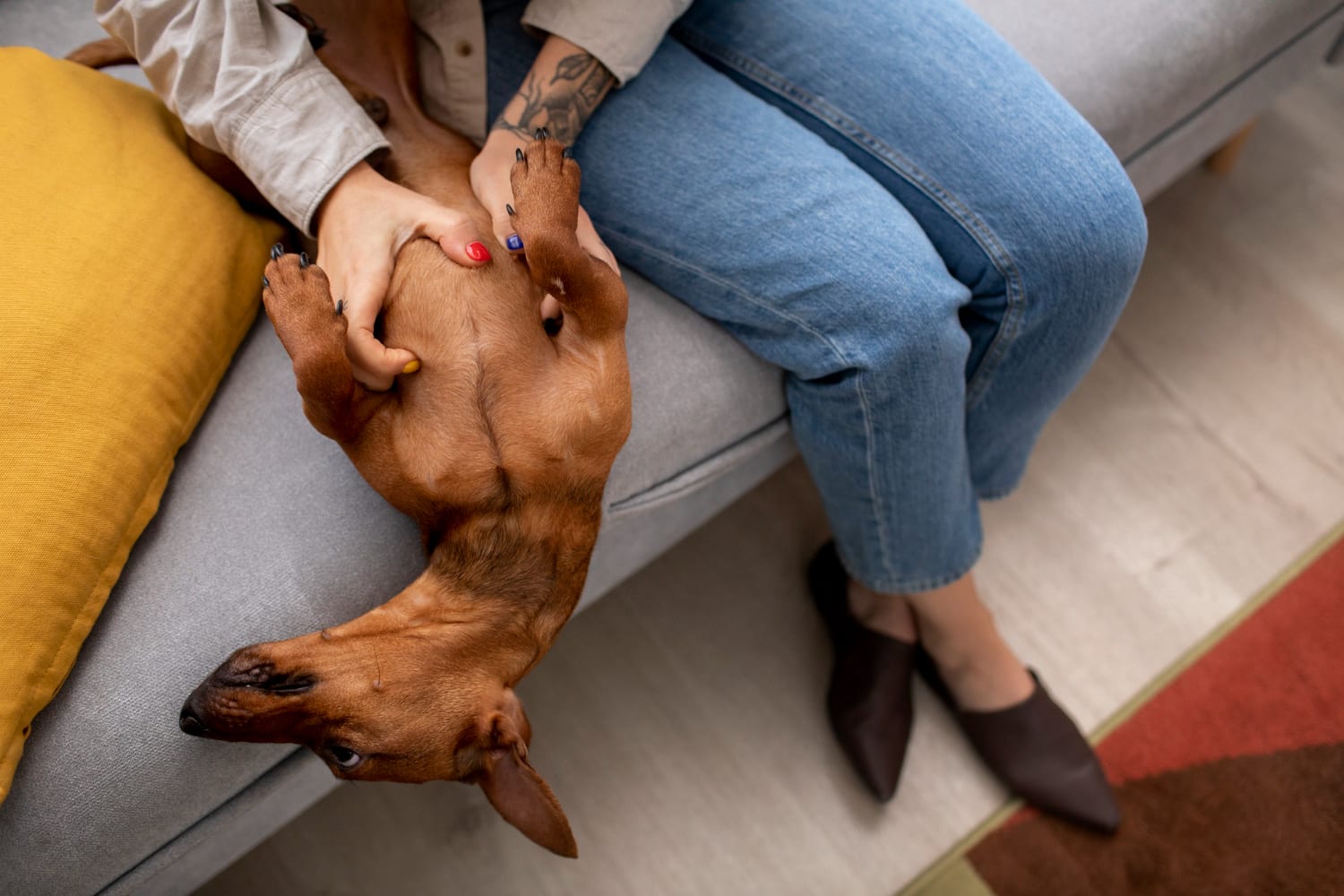Swollen Vulva in Dogs: Causes and Treatment

By Evelyn Harcourt
juin 09, 2025 - 1 min read
The vulva is the external and visible part of your female dog’s reproductive system, so any changes in its appearance are easy to spot. This is especially true in short-furred bitches. A swollen vulva is normal in some situations but can signify something is amiss.
Here, you’ll learn all about the reasons a female dog’s vulva can swell, how you can determine what the issue is and what intervention may be needed. This article discusses steps to help from home and when a neutering surgery is worth considering.
What is a Swollen Vulva in Dogs?
The vulva is the opening of the reproductive tract that is in between the female’s legs, below her anus. It is always visible but usually not prominent. It is a good idea to take a look at her vulva, so you know what her normal looks like.
When the vulva is swollen, the tissue becomes fuller and plumper and may also darken in colour. Swelling does not always indicate a problem, but it can be in some situations.
Is Vulva Swelling Normal?
We expect to see vulva swelling in some circumstances, and knowing when this occurs helps prevent unnecessary worry.
Swelling During Heat
During the pro-oestrus stage of a female’s reproductive cycle, her vulva becomes swollen and puffy. It is the hormone oestrogen that triggers these changes.
As she progresses into the oestrus phase, the female’s vulva becomes softer. She is then receptive to males and will allow them to mate.
Swelling in Puppies
The first time your puppy experiences a season, you will notice her vulva is much more prominent and visible than it would otherwise be. This can occur any time between the ages of six and eighteen months, with smaller breeds coming into heat earlier than larger breeds.
Swelling After Giving Birth
Towards the end of her pregnancy, your female will likely experience some minor vulval swelling. After birth, the vulva is even more swollen, but this settles down over the next few weeks.

Common Medical Causes of a Swollen Vulva
There are plenty of other causes for a female’s vulva to swell, and these ones require medical attention.
Allergies or Irritants
A dog with atopic dermatitis or allergies can be itchy anywhere, and excessive rubbing or chewing on or near the vulva can cause it to swell. This sometimes goes hand in hand with impacted or infected anal glands and bum scooting.
Similarly, if your dog sits on an irritant like a chemical cleaner or nettles, her vulva and the skin around it may become red and inflamed. This is inevitably associated with signs of itching and discomfort, such as excessive licking of the area.
Vaginitis or Infection
Vaginitis (vaginal inflammation) sometimes occurs before the first heat cycle, and then resolves once the female has had her first season. This type is known as ‘puppy vaginitis’. However, bitches of any age can develop vaginitis. As well as vulval swelling and discharge, your dog may lick excessively and pass urine more often.
For some, there will be an associated vaginal or urinary infection, but this is not always the case. Other potential triggers include urinary incontinence or simply having an immature reproductive system.
Urinary Tract Infections (UTIs)
UTIs can cause a burning sensation, constant straining, and itching of the urinary tract. For this reason, it is little wonder that we sometimes see vulval swelling at the same time.
Toilet training can go out the window, and you may notice accidents around the home.
Tumours, Cysts, or Growths
Less commonly, vaginitis is associated with a growth. These warts, tumours or cysts may be visible, or can occur within the vagina.
In some countries, dogs are infected with Transmissible Vesicular Tumours (TVTs) after mating, but this is not the case in the UK.
Trauma or Injury
Sometimes, vulvar swelling is triggered by trauma. This can occur while mating or during a fight with another dog.
We can also see foreign bodies within the vagina, such as a grass seed which has tracked in after getting caught in the fur.
Vaginal Hyperplasia
A massively swollen vulva is likely a case of vaginal hyperplasia or a vaginal protrusion. There is a great deal of swelling, and it can look like a pink balloon is coming from the vulva.
Breeds including the French Bulldog and Pug are at the highest risk and may develop signs when in heat. If your female has any trouble passing urine alongside the swelling, this would warrant an immediate visit to the emergency vet.

Symptoms That May Accompany Vulvar Swelling
For most, the swelling will be accompanied by other signs.
Vaginal Discharge
The swelling can be accompanied by discharge, which may be clear, bloody or yellow. When the discharge has a foul smell, it is often a sign of a bacterial infection. During the oestrus cycle, the discharge starts as blood and then becomes clearer.
If the bleeding associated with your female’s season is excessive or continues for more than two or three weeks, this can result in anaemia. In this case, contact your vet.
Excessive Licking or Discomfort
You might notice your female is paying her back end a lot more attention, and frequently turning to lick or nibble at it. She may also show signs of discomfort, such as whining when passing urine.
Another possible symptom would be ‘bum scooting’, when the dog drags her bottom across the floor, in an attempt to relieve the itch.
Changes in Urination
We sometimes find that the female is passing urine more often, and urinating in drips and drops. This is particularly common when they also have a urinary issue, such as a UTI or bladder stones.
Remember that a female in season will also pass urine more often, as they attempt to spread the word to the local males they are available to mate with.
Other Signs
Other signs can include lethargy or stomach upset. These are seen with the hormonal changes of being in season, but can also be signs of an infection.
Diagnosis: How Vets Determine the Cause
Any vulvar swelling not associated with pregnancy or the oestrus cycle is worth investigating.
What Your Vet Will Ask
When you see your vet, they will want to know if your female has been spayed or if she is in season.
They’ll also ask about any new signs (such as urinating more often) and when this began.
Physical Exam and Diagnostic Tests
Your vet will visually assess the vulva and should also perform a nose-to-tail check. They’ll perform a rectal exam to see if the anal glands need emptying and may also perform a vaginal exam and cytology (to determine the stage of oestrus, where appropriate).
When a urinary issue is considered, your vet may discuss a urine analysis and bladder imaging. If there is any discharge coming from the vagina, a swab may be taken to check for evidence of an infection.
Masses that appear suspicious can be sampled (Fine Needle Aspirate or biopsy), which is generally done under deep sedation or general anaesthesia.

Treatment Options for a Swollen Vulva
How the swelling is addressed will depend on the underlying cause. As mentioned, the swelling associated with hormonal changes and pregnancy would be expected and needs no treatment.
At-Home Care and Hygiene
When licking is excessive, a Buster collar should be used to stop it. Very swollen tissue should be cleaned regularly using cotton wool and warm, salt water.
Clipping the coat (‘hygiene clip’) for those with long fur can make life much easier.
Your dog may appreciate some distraction from the discomfort, such as a food puzzle, a long ‘sniffy walk’ or a training session.
Medical Treatments
When an infection is found, it will be treated using systemic antibiotics. Depending on the severity of the swelling, the dog may also need a course of anti-inflammatory medications and pain relief.
Surgical Intervention
Surgery may be indicated for those with masses, or when there is a foreign body which has lodged within the vagina.
When to See a Vet
Organise a vet visit if you notice your dog has vulvar swelling but is not going into season or pregnant. Similarly, it should be seen if it has any unusual discharge or is paying much more attention to its back end than usual.
Preventing Vulvar Issues in Dogs
We cannot always prevent vulvar issues, but some interventions can be helpful.
Benefits of Spaying
Spaying has many medical benefits and is generally recommended by vets for cats and dogs, when a female will not be used for breeding.
Spaying means a female will no longer cycle and it also makes any episodes of vaginitis or vaginal hyperplasia far less likely.
Spaying eliminates the risk of uterine and ovarian tumours and pyometra (uterus infection). The ideal time to spay depends on several factors, including a dog’s breed and personality. This is something best discussed with the dog's vet.
Regular Check-Ups and Hygiene
When you own a female dog, be aware of what their vulva typically looks like. Trimming the fur in this area can be a good idea, so any issues are detected early on.
Healthy adults should see their vet at least annually for a checkup. Older dogs should be seen more often, at least twice a year.
Learn More About Swollen Vulvas in Dogs
We are here if you have concerns about your dog and her vulva.
Contact us to discuss any concerns you have, such as whether your dog's vulva looks abnormal or she is having any unexpected discharge.
Continue reading

Signs a Cat is in Pain and How to Recognise Them
Learn how to recognise pain in your cat and the subtle signs to look out for.
Read article
What to Do If Your Dog Eats Chocolate?
Learn what to do if your dog eats chocolate and the signs of toxicity to look out for.
Read article
Signs of Hypothermia in a Dog and How to Treat It
Learn the signs of dog hypothermia and how to treat it quickly and safely.
Read article